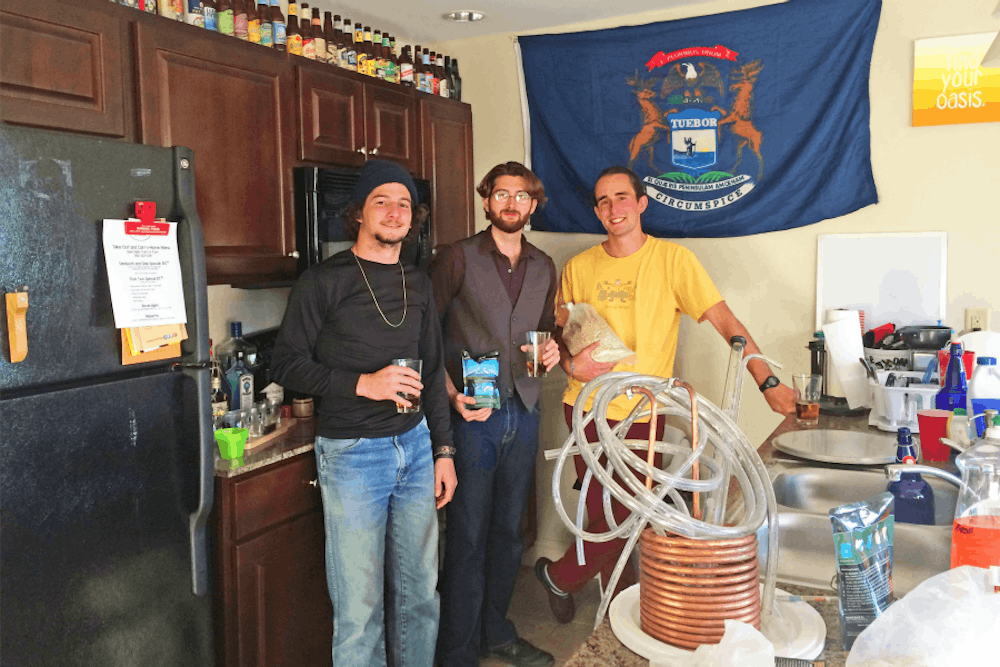By Mary Schrott, Senior Staff Writer
Senior Garret Gust's small Uptown apartment filled with muffled laughs as the afternoon sun shot through a window, making the individual beer bottles lining the kitchen cabinets glitter. Gust and his friend, Robert Marks, are concocting beer in the kitchen.
"I began brewing my senior year of middle school," Marks, a senior, said from behind a kitchen counter cluttered with pipes and basins that resembled a science lab.
"So, in eighth grade," Gust jokingly responded to Marks, sliding behind him quickly to grab a clear glass tube from the mess of instruments.
Marks' first brew looked very different from the "hoppy wheat ale" he and several friends were working on Monday in Gust's apartment.
"I had bought my dad a 'Mr. Brew' kit as a joke, but he doesn't read instructions so I ended up doing everything," Marks said.
Marks' early start in beer brewing brought him to the Western Program at Miami, where he is majoring in sustainable brewing practices.
Miami's Western Program "is dedicated to developing students as independent thinkers" and students have the opportunity to create their own majors, according to the program's website.
While Marks has been brewing for nearly eight years, he only started brewing with Gust, whose senior project for the Western Program is a study of the craft brewpub scene, and other friends at Miami early last semester.
"It wasn't hard to get along," said senior Lucas Wagner, who is also in the Western Program and a part of Marks' brew team. "'You like beer?' 'I like beer!' 'We should make some,'" Wagner light-heartedly recalled the beginning of the group's friendship.
Craft beer has exploded in popularity over the past several years. According to the Brewers Association, the volume of craft beer production increased by 18 percent and 22 percent increase in retail dollar value in 2014.
"This steady growth shows that craft brewing is part of a profound shift in American beer culture," said Bart Watson of the Brewers Association in a release. "Small and independent brewers are deepening their connection to local beer lovers while continuing to create excitement and attract even more appreciators."
The brewing process for beer at home only takes several hours. However, the beer cannot be consumed until fermentation is complete, which takes a week, at minimum.
To aid in the waiting process, drinking beer while brewing is an essential step, according to Marks and his friends.
The batches they make yield 55 to 60 beers and can be made for $35 total, Gust said. As for what they do with their product, most of it is for themselves or people who follow what they are doing like their professors and friends.
To calculate proportions, Marks uses a free software called Brewtarget that helps control color, bitterness and other parameters. Marks uses other beers as inspiration for his own creations.
"We find a brew we like, and then we tweak the recipe for things we didn't like or things we thought we could do differently," Marks said.
Despite the precision that goes into each batch, Marks said some of his best creations were born out of mistakes.
While the experimental aspect is alluring to Marks, Gust said the ability to personalize and socialize over craft beer is his favorite part.
"It's a very local experience and that's cool," said Gust. Picking ingredients, creating brewing processes and naming batches are all aspects that make craft beer special for him.
Marks also appreciates the local aspect of craft beer for environmental reasons.
"Beer is an extremely wasteful process and I'm not convinced I like the fact it exists in the first place," Marks said. "[Beer is] not necessary. We don't need to produce [it] for any reason, but if we are going to continue to produce [it] we might as well use the most efficient, least environmentally harmful way of producing [it]."
For Marks, this means local beer that isn't distributed very far because the distribution process wastes energy and burns fossil fuels.
According to to the Brewer's Association, most Americans live within 10 miles of a brewery. Compared to the rest of the world, the U.S. market has the most styles and brands of beer to choose from.
While Marks admits that there isn't much money in beer, he said after graduation he hopes to get his bartender's license. His ultimate career goal is to be a consultant for breweries.
"I'd rather do something that I feel is helping people and the environment," Marks said.
While Marks and his friends enjoy craft beer, they believe the niche hobby will eventually reach other undergraduates.
"I think craft brewing is going to be huge on the university scene," Gust said. "I know friends [from other schools] that have a student-run brewery and sell it at their student union."
While there are many bars in Oxford, Marks says the best places to enjoy craft beer are Quarter Barrel, which has its own brewery, and Circle Bar and Mac n' Joe's.
Brewing together at home or grabbing a six-pack with friends, however, is Marks' favorite way to enjoy a beer.
As Marks and Gust fiddle with a thermometer in a large stock pot sitting on the stove, they make sure the water is the right temperature before adding their ingredients.
Pushing up his glasses and flicking his hair from his eyes, Marks steps back from the contraption.
"Yeah, we are going to be here for a while," Gust said to Marks.
"It's okay," he said. "We got beer to drink."

